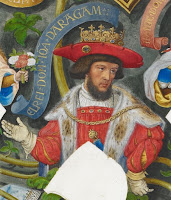Through Blanche's position as her father's heir, she and John became queen and king of Navarre upon the death of Carlos III on 8 September 1425, although their coronations did not take place until 15 May 1429.
Blanche devoted herself to religious causes. She supported several charities and founded hermitages. She supported the hermitage of Santa Brígida near Olite, the royal seat of her father.
In 1433, she made a pilgrimage to Santa María del Pilar (Cathedral Basilica of Our Lady of the Pillar) in Zaragoza, in Aragon. With her went her eldest son by John, Charles of Viana (1421 - 1461), and John's royal chamberlain, Juan Vélaz de Medrano IV, who had been Carlos III's chamberlain.
During the pilgrimage, she established a chivalric brotherhood consisting of her son Charles, 15 men and nine women. They were all committed to regular fasting, almsgiving, prayer, and vigil observances of important holy days. They wore blue sashes (symbolic of the Virgin Mary) embroidered with a gold pillar and the motto A ti me arrimo ("I lean on you").
Blanche and John had three children besides Charles. Joan of Navarre only lived a couple years (1423 - 22 August 1425). Blanche of Navarre (1424 - 1464) married Henry IV of Castile but never consummated it in 13 years, after which Henry divorced her. Eleanor, born 1426, became Queen of Navarre until her death in 1479.
When Blanche died on 1 April 1441, she was buried in the church of Santa María la Real de Nieva. The illustration shows a likeness of her in that church.
So...what was the deal with the pillar? How was Mary associated with a pillar in Spain? That's a story for tomorrow.




